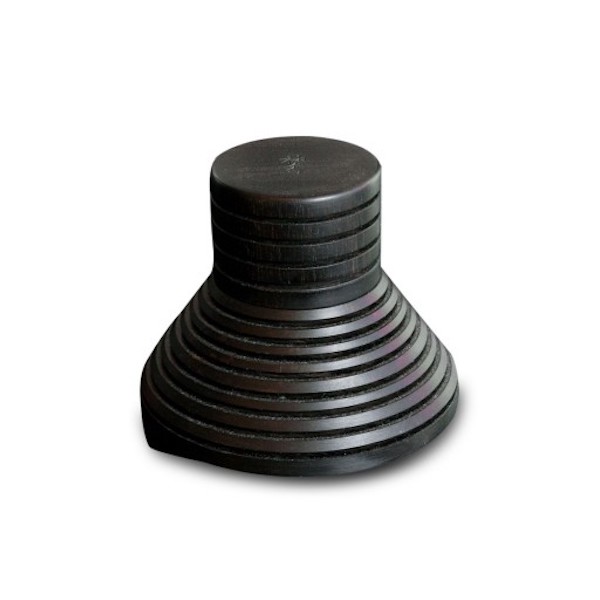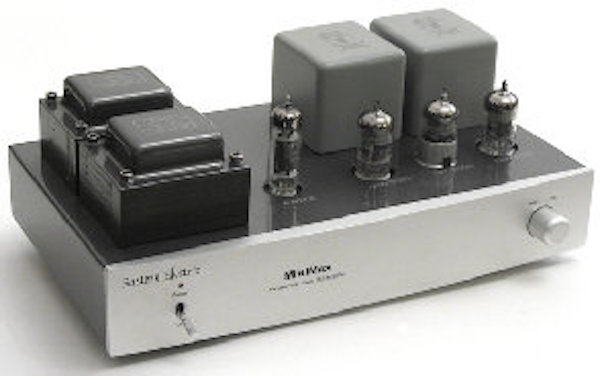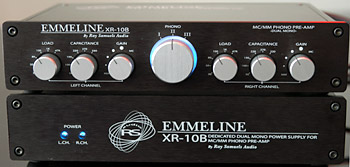Analog Corner #123

Putting a weight on the spindle or screwing on a clamp damps the vinyl and causes it to make better contact with the platter or mat, which can also help with damping. The frequencies damped and the efficacy of the damping change depending on the weight and the material used in the clamp, and that will change the resulting sound. It’s a mystery to me why some people find this mysterious.
I’ve been playing with a bunch of record weights, including the beautifully machined DampClamp from Locus Design Group (no longer in business) and its lighter cousin, the BasiClamp; the Hagerman Technology UFO Strobeclamp, a do-it-yourself project that works without weight; and the (in)famous Shun Mook LP Record Clamp.
The gleaming Locus Design Group DampClamp ($399, www.locus-design.com) has two weights CNC-milled from billet aluminum and constrained-layer-damped with a layer of IsoDamp, a visco-elastomer compound. The designer claims that vibrational energy is turned into heat because the IsoDamp between the two weights literally shears, ever so slightly, from the absorbed energy, turning it into heat.
The DampClamp is designed to cover most of the record label, meaning if you don’t lift the stylus at the end you’ll get an ugly rubbing noise and possibly worse, depending on the width of your cartridge and headshell. When I wasn’t fast enough at lifting the stylus I never had a problem worse than an ugly grinding noise, but I wouldn’t use the DampClamp with wide-bodied cartridges, such as some Clearaudios. At 1.7 lbs, it’s too heavy for some ’tables, especially sprung ones. Definitely check with your ’table’s manufacturer before buying. Tall spindles can also be a problem. The BasiClamp ($99) is just a weight: half a DampClamp with no elastomer damping sandwich.
Which works best for you will be a matter of taste and associated equipment, especially platter and mat material. The DampClamp made an enormous difference on my Simon Yorke turntable with Bluebird mat: it damped, producing blacker backgrounds and greater overall clarity, but in my setup it overdamped, creating a thicker, heavier sound than I like. Bright setups and those in need of some rhythmic discipline and bottom-end weight may benefit greatly. I preferred the $99 BasiClamp on my rig, but the DampClamp may be your ticket to analog paradise. You’ll surely hear a difference with either of them—or with any weight or clamp.
The Hagerman Technology Uniform Frequency Orbiter (UFO) Strobeclamp ($75, www.hagtech.com) (seen at the top and no longer available) is a DIY kit that’s relatively easy to build: a three-speed, crystal-controlled electronic strobe using blue LEDs powered by two 3V camera batteries. Hagerman recommends using an aluminum “slug,” which you have to drill with a 9⁄32" bit (a drill press is highly recommended) and then epoxy to the strobe. Or use a hockey puck (!), which is what my prebuilt sample came with. The UFO is not elegant and is surely not for every taste, but it’s fun. It can be used to check your ’table’s speed (though its small scale makes it somewhat difficult to read) as well as damp it with the material of your choice. A hockey puck is cute, but neither heavy nor dense enough to make an effective damping material. I didn’t do a double-blind test of the Strobeclamp, and maybe it was my imagination, Arnie, but the sound seemed kind of glary and disorganized compared to the BasiClamp, and the bass was, er, rubbery (I swear!). An aluminum slug probably would work better with Hagerman’s useful outer-space strobe.

The LP Record Clamp, made of ebony briar, is neither a Band-Aid for an analog front end in need of help nor, at $1800 (now $4800), the icing on the cake of a great analog rig; it’s more of a dusting of confectioner’s sugar atop the icing. Wow, is it sweet! I’ve just compared Elvis Costello’s heart-wrenching antiwar song, “Shipbuilding” (inspired by Margaret Thatcher’s Falklands war), from an original EU edition of his Punch the Clock, and each weight had it sounding different—especially Chet Baker’s aching trumpet solo. But it was the $1800 ($4800) Shun Mook clamp that just plain made it come alive. For $1701 less, the Locus BasiClamp was a good if very distant second. I’m happier to report that.
While I didn’t do “scientifically sanctioned” double-blind tests on these weights, I did have a friend alternate the two Locus weights and the Shun Mook on the fly as I listened, not knowing which was which. (The Hagerman hockey puck required too much downward pressure to take part.) Then I did the switching while my friend listened. We both preferred the Shun Mook; the BasiClamp came in second, the DampClamp third because it sounded “too dead”—even though killing off all secondary parasitic resonances in the vinyl would seem to be the ideal.
Tonearm weirdness

Eastern Electric MiniMax phono preamp

The MiniMax’s build and parts quality seem quite high, especially at its price of $1499. Key to the design, I was told , were the high-quality transformers: one for the power supply, plus an equally large choke, plus a pair of large Permalloy-core MC step-up transformers. Add point-to-point signal-path wiring, what appear to be high-quality circuit boards for the rest of the power supply, and hardwired, chassis-mounted, gold-plated RCA jacks, and you have what appears to be a sumptuous piece of kit, as they say in the UK. The MiniMax is imported by Morningstar Audio (www.morningstaraudio.com), which offers a two-year warranty on parts and labor, 60 days on tubes (footnote 1).
Dual taps on the MiniMax’s MC transformer provide 40 and 100 ohm inputs to better match cartridge internal impedance with transformer impedance for maximum power transfer. Gain is said to be 42dB (MM) and 57dB (MC), which should be sufficient for all but the lowest-output MC cartridges, while the claimed signal/noise ratios are a respectable 90dB (MM) and 87dB (MC). The input sensitivities are 15mV (MM) and 4mV (MC), the maximum output a healthy 20V.
To test the MiniMax’s MM input I installed Sumiko’s superb-sounding, high-output MC Blackbird ($750). The MiniMax’s first obvious quality was the 12AX7 tube’s midrange magic—which I’m sure would be only more pronounced with some new old stock (NOS) Telefunkens or some other vintage tubes. Vocals were fleshy and palpable, and images had satisfying weight, body, and three-dimensionality on impressively deep, wide, and believable soundstages. Acoustic instruments were rendered naturally with no hint of etch or artificial electronica. String tones were rich, full-bodied, and well textured. Brass and percussion were somewhat muted and softened, however, with rounded transients.
I pulled out an original Parlophone pressing of the Beatles’ A Hard Day’s Night and compared the MiniMax’s performance with both the Manley Steelhead ($7300) and the Graham Slee Era Gold Mk.V ($925, MM only) phono preamps, the latter my benchmark MM preamp. The MiniMax’s midband performance was stellar without regard to price. Compared to the other two preamps driven by the Blackbird, the MiniMax’s slight midbass warmth—right where it’s needed with small, honest, two-way speakers—pleasingly brought out the bongos on “You Can’t Do That,” though not to the point of turning the picture soggy or limp. The MiniMax’s high-frequency performance in MM mode was slightly muted, and transients were somewhat soft compared to the Manley and Graham Slee, though neither of those had the MiniMax’s special midrange glow. Whether that quality will swamp your system or complement it, I can’t say. But if I were running an MM or a high-output MC cartridge, I’d save $600 and opt for the Graham Slee—it was both more extended on top and noticeably more dynamic and detailed, if not as rich-sounding in the mids or as warm and pronounced in the bass and midbass.
Switching to MC substantiated importer Morningstar Audio’s claim that the MiniMax’s magic was in its step-up transformers. You pay a relative premium for them, so why waste your money if you’re not going to use them? Don’t consider the MiniMax if you’re running an MM or a high-output MC. When I drove the MiniMax with the Lyra Titan cartridge, which costs three times its price, the preamp opened up dramatically on top while maintaining its addictively sweet midrange.
The Lyra Titan’s 3 ohm internal impedance suggested that it might sound better connected to the transformer’s “low” (40 ohms) tap, which it did; why the 100 ohm tap sounded so much brighter I don’t know. The Steelhead’s higher-impedance taps choked off the highs, which makes sense: efficiency was hindered. The Eastern Electric’s input choices behaved more like resistive loading than transformer matching. Perhaps the designer or importer can explain.
In any case, when driven by a top-shelf MC phono cartridge, the MiniMax sounded laughably good—be prepared to give up the dynamic scaling of far more expensive phono preamps such as the Steelhead. And while the MiniMax’s bass was well-controlled and taut, it wasn’t nearly as extended or as fully developed as you’ll hear with far more expensive phono preamps. But I don’t think most buyers will use the MiniMax with a +$4000 cartridge or the super-revealing Wilson Audio MAXX2 loudspeakers.
Eastern Acoustics’ MiniMax phono preamp is on the mellow side, addictive in the midrange, rhythmically together, reasonably extended and “fast” on top in MC mode, and just plain fun to listen to and look at over the long haul. It succeeds mightily by committing only sins of omission. I regret not having had on hand an EAR 834P ($1200) to make some comparisons, but for $1499, I don’t see how you can go wrong with the Eastern Electric MiniMax. Tube rolling can only heighten the pleasure (and probably the noise, too, but nothing’s free).
Ray Samuels Audio Emmeline XR-10B phono preamp

The gain ranges from 40 to 70dB, and the loading options are 30, 50, 80, 100, 1k, and 47k ohms, while the capacitance can be set from 50pF to 330pF. Balanced and unbalanced outputs are provided, with both available simultaneously and no pins to ground. The maximum output is claimed to be 18V, with RIAA accuracy “around” 0.1dB from 15Hz to 20kHz. (The XR-10B’s input sensitivity, overload margins, and signal/noise ratios were not listed in the specs.) All of this is contained in two relatively small boxes 9" wide by 6" deep by less than 2" high. The XR-10B is built and hand-assembled in the US using hand-matched components, and all units are burned in before shipping. The price is $4500.
The first things the buyer needs to ask when considering such a product is Do I need this much switching flexibility? and Do I need three inputs? Because that’s a lot of what your $4500 buys. A reviewer will find both indispensable, but unless you have multiple tonearms and/or turntables, you’re buying options you don’t need. But if you’re concerned that all that switching circuitry will degrade the signal, let me allay your fears: However Ray Samuels has configured it, and despite all its switches, the XR-10B’s resolution, dynamic range, and frequency extension—especially its low-bass depth and grip—were astonishing. I can get 20Hz and below from my Wilson Audio MAXX2 loudspeakers, and the XR-10B was well up to that task. I was reminded mostly of the overall presentation of the more expensive, battery-powered Friedrich Schaeffer ASR, and that’s high praise indeed. (The ASR is actually two complete phono preamps on a single chassis.)
The Emmeline XR-10B’s transparency and resolution of low-level details were about as close to “in the studio” as I’ve heard from a phono preamp. While it wasn’t quite as suave as the far more expensive Boulder 2008, it generated the same level of excitement in terms of immediacy and, especially, rhythm’n’pace. Backgrounds were jet-black. Transients were crystalline pure without sounding hard or etched, though I preferred the Lyra Titan cartridge loaded down to 100 ohms through the XR-10B; otherwise, it tended to sound a bit bright.
When I again played the Beatles’ A Hard Day’s Night using the Lyra Titan, it sounded like a different album from how it had sounded through the warm MiniMax. It wasn’t nearly as lush and rich, but instrumental and vocal separation and the ability to hear all of the studio tricks and moves in the mix—particularly the artificial reverberant field in which the group was placed—were revelatory. Especially noticeable were the clarity and articulation of the tambourine in “I’ll Cry Instead.” The vocals were laid out with the unforced delicacy and palpability I’m used to hearing from the far more expensive Manley Steelhead, though the XR-10B lacks the Steelhead’s slight tubey bloom.
When I compared the 180gm and 200gm Quiex SV-P pressings of Classic Records’ vinyl reissue of Crosby, Stills & Nash (Atlantic SD-8229), the differences were exposed with ease: the 200gm version, pressed from the same mastering, offered far tighter, deeper, and more expressive bass. Dynamics were noticeably better, transparency was increased, and the top end was smoother and more transparent, yet transients were sharper and faster. I’d never heard CS&N sound this good before. Recordings with more natural reverberation proved equally revealing. The XR-10B dug up all of the details and laid them out for me to enjoy with natural, nonmechanical ease.
The XR-10B will sound bright in some systems even if you load down your cartridge, and will probably sound threadbare in the midband in others—and if like the sort of warmth and velvety richness the MiniMax provides, you might think the XR-10B sounds “electronic” and somewhat parched. But I don’t, especially because of the top end’s delicacy and cleanness, which were addictive. Still, the XR-10B did emphasize transient attack over harmonic development, and I’ve heard richer string tone. If your system needs more richness, this may not be the phono preamp for you. On the other hand, if your system is a bit sluggish and syrupy, the Emmeline could provide a wakeup call.
Needless to say, a phono preamp this revealing demands a careful choice of cables. I found the Shunyata Research Antares to be the ideal match for the XR-10B. It has the midband richness the XR-10B needs without compromising its transparency and speed. It produced just the right balance to let strings sound rich and full yet still well detailed. Don’t prejudge the ultrarevealing XR-10B before considering the cables you’re using.
Although my review sample of the Emmeline had been broken-in by Ray Samuels himself, I found it needed a few more days of warmup and use before it began to cohere and sound musically together—especially on the bottom. Once it locked in, though—and with the Wilson MAXX2s, which really plumb the depths—I knew it! I found the XR-10B equally good in MM and MC modes. The combo of the $750 Blackbird and the XR-10B was nothing short of synergistic and sensational, the cartridge’s upper-midband richness perfectly complementing the preamp’s transparency and transient speed. But the XR-10B’s resolution demonstrated why the Blackbird costs $750 and the Titan $4500.
The Ray Samuels Audio Emmeline XR-10B is to phono preamps as electrostatics are to loudspeakers: lightning-fast, transparent, clean, quiet, and extended on top. But unlike most electrostatics, it has awesome dynamics at both ends of the scale, subwooferlike bottom-end extension and control, and it doesn’t “beam.” If your musical tastes are mostly rock and jazz and you can spend $4500, the XR-10B should be on your short list, especially as it comes with a try-it-at-home, no-obligation, money-back guarantee. How can you go wrong? The XR-10B is a sensational phono preamplifier. If I didn’t already own the Manley Steelhead, I’d probably end up buying it. It’s that good.
Footnotes
1. Morningstar Audio Imports, 44 East University Drive, Arlington Heights, IL 60004. Tel: (847) 255-1150. Fax: (847) 255-1878. Web: www.morningstaraudio.com.
2. Ray Samuels Audio, 8005 Keeler, Skokie, IL 60076. Tel: (847) 673-8739. Web: www.raysamuelsaudio.com.
Sidebar: In Heavy Rotation
1) The Royal Ballet, Gala Performances, Classic Records/RCA, 9 one-sided, 200gm, Quiex SV-P LPs
2) Johnny Cash, Original Sun Singles '55–'58, Sundazed, 2 180gm mono LPs
3) Paul Desmond, Take Ten, Speakers Corner/RCA, 180gm LP
4) Arturo O'Farrill, Live in Brooklyn, Zoho, CD
5) Ry Cooder, Chávez Ravine, Nonesuch, CD
6) Brian Eno, Another Day on Earth, Opal/Ryko, CD
7) Al Cohn, On the Saxophone, Sundazed/Euphoria, 180gm mono LP
8) Jazz Artists Guild, Newport Rebels, Pure Pleasure/Candid, 180gm LP
9) Laurindo Almeida/Charlie Byrd, Tango, Groove Note/Concord, 2 45rpm, 180gm LPs
10) John Lennon, Mind Games, Mobile Fidelity, 180gm LP






















































